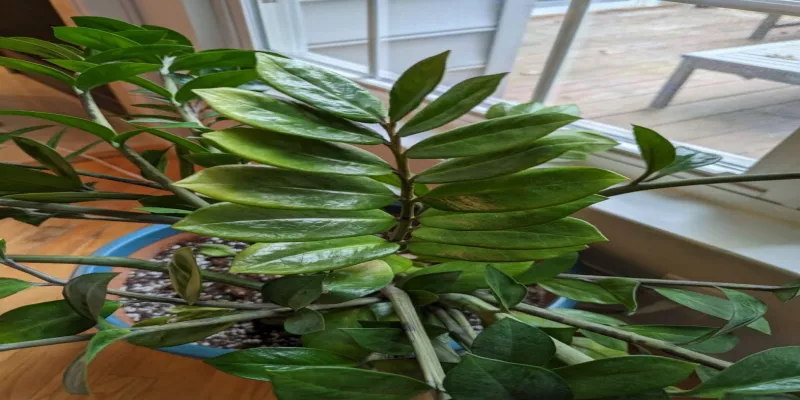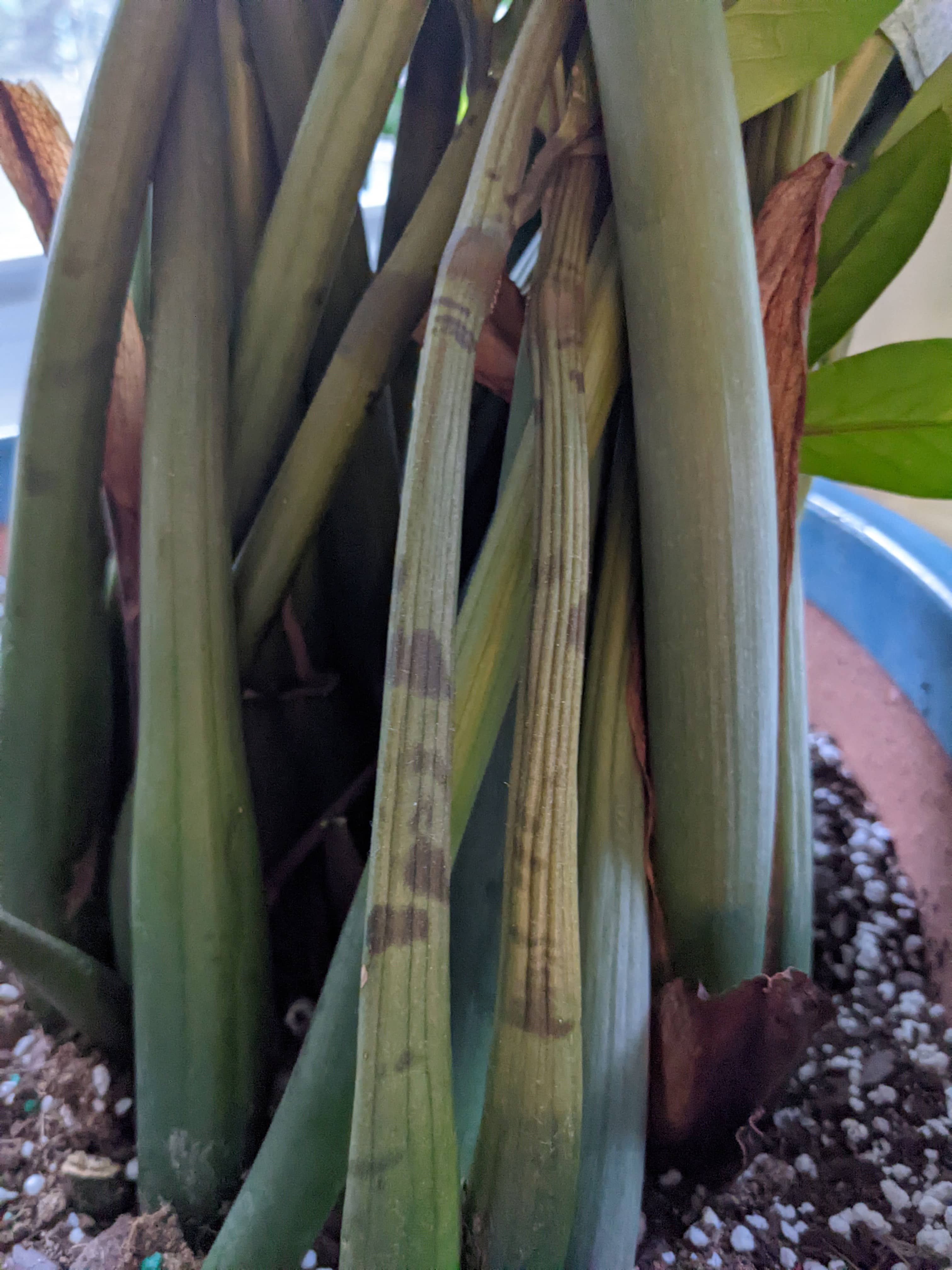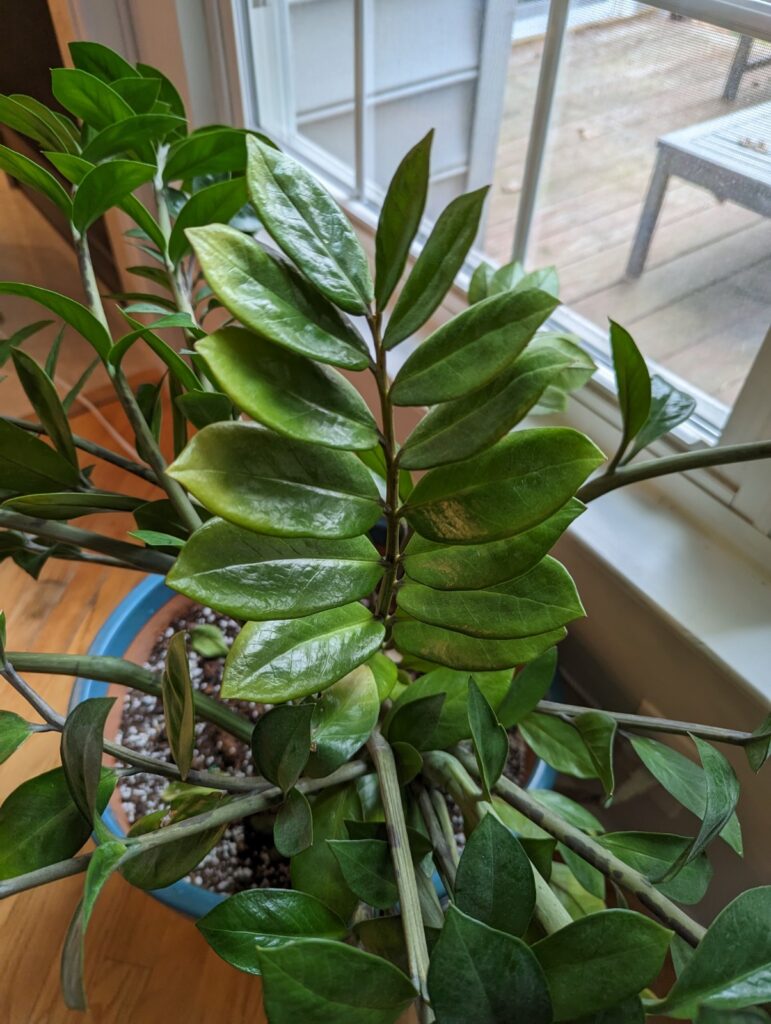Do I Have An Underwatered ZZ Plant

ZZ plants have become very popular houseplants. I think they are often recommended as easy to care for because they can tolerate lower light levels and also they do not need to be watered very often. Their popularity may also be due to their beauty, ZZ Plants have plump stems and shiny dark green leaves. Although they have low water needs that can easily lead plant owners to inadvertently underwatering their ZZ Plant. Read on to learn some of the most common signs that you have an underwatered ZZ Plant and some other things you may want to look into instead.
Signs of an Underwatered ZZ Plant
An underwatered ZZ Plant may show several different signs to let you know that it needs some moisture. One sign to look for is wrinkled stems. The ZZ Plant typically sports plump stems and when the plant is lacking moisture those stems lose their plumpness. See the picture below for an example of what wrinkled stems looks like.

Another sign that may indicate underwatering is yellow leaves. ZZ Plants typically have darker green leaves, except when the stem is first growing out of the soil, then the stem and leaves are lighter green. What is not normal is yellow or brown leaves. When leaves become yellow and brown, they are dying. Yellowing leaves can be a sign that you have underwatered your ZZ Plant. However, it can also mean that you have overwatered your ZZ Plant. I know that's confusing.
Note your plant does not have to have both wrinkled stems and yellowing leaves for it to be underwatered. In fact, it doesn't have to show either of those signs.
How to Detect and Fix Water Issues
The best way to tell if there is a water issue (over- or underwatering) is to use a soil moisture meter. I use something simple like this soil moisture meter. The meter takes the guesswork out. You stick it in the soil and it lets you know how moist the soil is. The bonus is you can use it for all your houseplants. Some people stick their fingers in the soil to assess moisture. That seems too subjective to me, especially if you suspect you have a problem going on.
Underwatered
If you have confirmed you have been underwatering, you need to increase your watering in some manner. Either you water more often or you may supply a larger amount of water each time you water. It's important to find a balance because you don't want to overdo it and go too far the other way. If you have yellow leaves on your ZZ Plant, unfortunately, they will not regain their color. You can let them fall off or pull them off if you want to. If the stem is wrinkled and full of yellowing leaves you may just want to prune the whole stem. Once you begin increasing watering pay attention to whether the water runs quickly out of the pot rather than being absorbed by the soil. That's a sign that the soil may be hydrophobic. If that is the case, you should water your ZZ Plant from the bottom to give the soil some time to absorb water.
Overwatered
Fixing an overwatered ZZ Plant is difficult and depending on how overwatered we're talking there may be a low success rate. First, assess the damage by carefully removing your ZZ Plant from its pot. That will allow the roots, rhizomes, and soil to quickly dry. Once the roots have dried enough to handle, you need to inspect them for rot. Rotten roots will be brown and feel mushy. If you find rotten roots you need to cut them away with a clean sharp knife. Let the trimmed roots heal and callus over for a day or two, then you can repot your ZZ Plant in new soil and hope for the best.
Other Problems to Look Out For
Fertilizing Issues
If you suspect that your ZZ Plant is underwatered, it's probably because you noticed some signs like yellow leaves. Yellow leaves can also be caused by nutrient issues. Like water, nutrients can be oversupplied and undersupplied. However, yellow leaves are more likely a sign of under-fertilization rather than over-fertilization. Overfertilized ZZ Plants are more likely to exhibit slow growth or even wilting. Typical houseplant fertilizers have a balanced ratio of nitrogen, phosphorous, and potassium, or n-p-k, which you see on the labels of plant fertilizers. Leaf yellowing may be a result of a lack of nitrogen or potassium. Nitrogen specifically helps promote healthy foliage growth.

If you ruled out a water issue then you may want to look into fertilization. Signs of a fertilization issue generally show up on multiple stems and leaves rather than concentrated in one single area. You can kind of just ask yourself about fertilization if, you can't remember the last time you fertilized then you might be under-fertilizing. If you have been fertilizing, check your fertilizer and make sure you've been following the directions for dosing and dilution correctly. To confirm fertilizer issues, I use soil rapitest to check my plants. It allows you to test for ph and each of the three main nutrients individually.
How to Fix Fertilization Issues
If you have overfertilized your ZZ Plant, flush the soil by watering it a lot so that water runs out of the pot's drainage holes. Doing this will help wash some of the excess nutrients out of the soil. You can even remove the plant from its pot because that allows it to dry out more quickly after you have just soaked the soil. All this may be pretty shocking to your plant, so don't be surprised if it looks worse off to start.
An under-fertilized ZZ Plant needs to be fertilized. Water-soluble or liquid fertilizers provide the quickest absorption. If you don't opt for the soil rapitest that I linked earlier, you should stick to using a balanced fertilizer that has the same (or similar) number in the n-p-k ratio. However, if you know for sure you have a nitrogen deficiency for example, then you can find fertilizers that have higher ratios of nitrogen compared to the other two nutrients. It's essential to follow the instructions on the fertilizing product because some fertilizers require dilution.
Pest Issues
Again, if you've ruled out water issues yet you see concerning plant health signs like yellowing leaves, then you should check for pests. I actually recommend that you check your plants for pests weekly. This will ensure you catch any infestation early. A variety of pests attack ZZ Plants. The main pests that attack foliage, causing leaf yellowing, are aphids, scale/mealybugs, spider mites, and thrips. They feed on the leaves and ultimately destroy them. Yellowing from pest damage will appear spotty where the pests have damaged the leaves. If you catch an infestation early then the yellowing might be localized to a few leaves rather than widespread like for water and fertilizing issues. I recommend using a flashlight to help you see contrast and shadows when looking for pests. In addition, pay close attention to the underside of the leaves because pests often hide there.
How to Fix Pest Issues
Quarantine your plant away from other uninfested plants immediately. Pest infestations can spread quickly. Be prepared to repeat these steps over the next few weeks. Remove as many pests as you can visibly see. Most pests can be removed with a strong shower spray or a garden hose outside. I recommend the outside with a garden hose if you can, less risk of spreading your pests around inside your house. Scale and mealybugs require manual removal because they have an armor-like shell that even a strong spray will not budge. Scrape them off or use rubbing alcohol on a Q-tip to kill and remove them.
After removal, use an insecticide. There are organic versions, like neem oil, and inorganic ones, like insecticidal soap. I have personally used neem oil on spider mites successfully. One application of insecticide is never enough, you'll actually have to repeat removal and insecticide application every few days until you do not see pests for over a week. We do this because of the short lifecycle of these pests. Although you don't see them, their eggs may still remain and could reinfest your plant.
Hopefully, this helps you determine if your ZZ Plant is underwatered or some other problem, and also puts you on your way to fix it. Have any questions? Post them in the Comments section below.
Add new comment